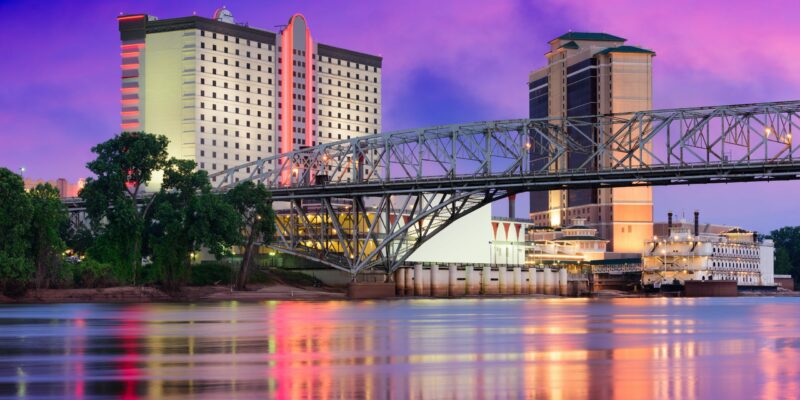A Bossier City Council on the verge of its biggest shakeup in nearly a quarter-century may soon reveal whether it has finally renounced its free-spending, money-wasting ways. After a promising sign at its last meeting, the upcoming session could provide a clearer answer.
This week, the Council will consider its annual five-year Capital Outlay Budget. While the plan may be altered at any time, it gives an idea of city priorities for infrastructure over the next half-decade.
As an example of how the city may pivot, earlier this month the Council considered fronting $80,000—plus a small contingency—for two electric vehicle charging stations atop the Louisiana Boardwalk parking garage, a structure the city gifted to developers two decades ago. This proposal stemmed from the federal government’s Volkswagen Environmental Mitigation Trust Fund program, which would cover the purchase and installation of light-duty direct current fast chargers (“level 3,” capable of a full charge in 20 to 60 minutes) along high-speed corridors like Interstate 20. A survey of available power infrastructure led to this specific location.
Earlier this month, the Council debated fronting $80,000—plus a small contingency—for two electric vehicle charging stations atop the Louisiana Boardwalk parking garage, a structure the city gifted to developers two decades ago. This proposal stemmed from the federal Volkswagen Environmental Mitigation Trust Fund, which would cover the purchase and installation of light-duty direct current fast chargers (“level 3,” capable of a full charge in 20 to 60 minutes) along high-speed corridors like Interstate 20. A survey of available power infrastructure led to this specific location.
Despite the chargers themselves costing less than half the grant amount, the remaining funds would cover installation, maintenance, and monitoring. The city’s contribution–at most, and it very well could be less, a mere $10,000 after reimbursement.
Yet the Council, which in the previous three decades had blown in the neighborhood of $200 million on a hardly-needed road, an arena, a high-tech office building, and the garage, balked at this. Members, including graybeard councilors Republican David Montgomery, Democrat Bubba Williams, and independent Jeff Darby who had gleefully stumped for the hundreds of millions of baubles, brought up liability and urgency concerns. Not even argued was who would pay for the electricity used, likely the city thus taxpayers.
However, declining a relative pittance for something few people will use and likely nobody the graybeards know is one thing. Plopping down something in the tens of millions of taxpayer dollars that some people will use, a lot of people will see, everybody pays for, and political allies will enjoy is another thing. And so, like herpes, the idea of the “Multi-Purpose Indoor Sports Venue” recurs in the 2025-26 plan, this time at the cost of $20 million which just barely (behind Tinsley Park improvements) represents the second biggest project, or just over 15 percent of the projected over $129 million total.
This is shorthand for a gift building for the local YMCA, which first came up just after elections in 2021 at Montgomery’s suggestion, then priced at $30 million. It received a cold shoulder then, and again at the end of the year with a veto threat from GOP Mayor Tommy Chandler. Basically, the Y would run it and city residents could pay dues in the hundreds of dollars a year to use it, as opposed to using any other area Y or other nonprofit or for-profit health clubs.
In other words, it was another needless waste of taxpayer dollars. Despite its repeated rejection, the project keeps creeping back into the budget. After initially lying low in the 2022 version, it resurfaced in the 2023 Transportation Improvement category at $25 million, with $10 million allocated for fiscal years 2024-25 and 2025-26. In 2024, it was quietly moved to the Engineering category with the same funding timeline, starting in FY 2026. This year, it remains in Engineering, now reduced to $20 million, with half budgeted for FY 2027 and the rest spread in equal installments over the following two years.
So why does the Council keep approving it—only to keep delaying it? Why hasn’t Chandler voiced opposition? Couldn’t something more useful take its place?
Before breaking ground, several steps—land acquisition, contracting, and final approvals—must occur. The incoming Council, to be decided in next month’s elections, is expected to be far less willing to fund vanity projects. With Democrat Charles Gray disqualified from running in District 3 (ironically, the same way he won his Police Jury seat in 2019), a fiscally responsible majority could soon take over. If the Council’s recent rejection of the EV charger grant signals a shift toward financial prudence, why wait? Why not cut this wasteful project now?
Montgomery and Williams, along with another graybeard whose votes only were responsible for half the waste of the others, Republican Jeff Free, all are jumping ship by mid-year. Still, Darby is running for reelection, as is the graybeards’ lapdog, first-term Republican Vince Maggio. If they want to improve their standing with voters, they could join verified public weal watchdogs Republicans Chris Smith and Brian Hammons in evicting that line item.
If they do, it will be a sign that a long-overdue revolution of fiscal sanity has finally arrived—perhaps a few months early, but far too late for the millions already wasted.
Advertisement
Advertisement

